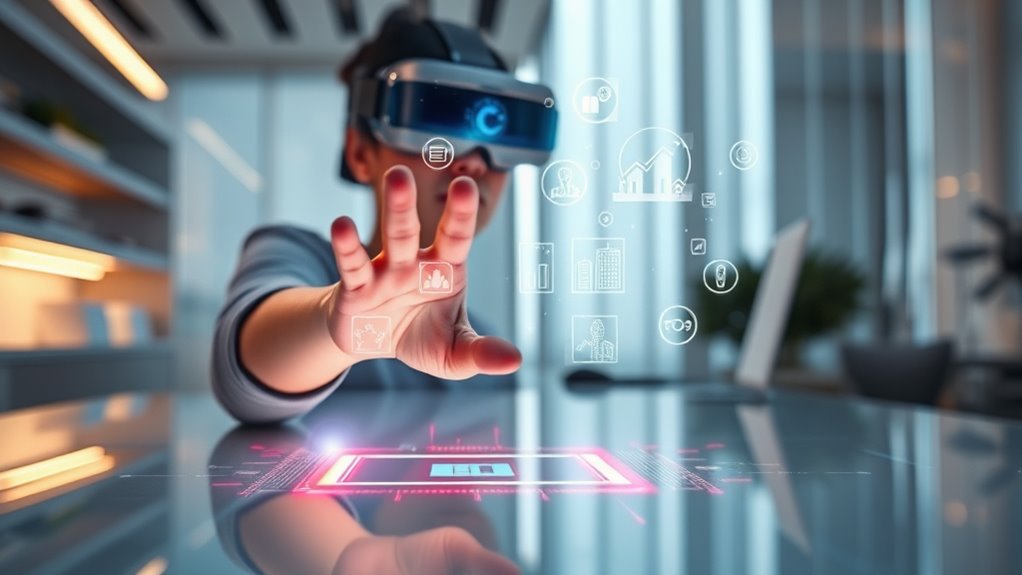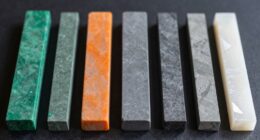Advances in tactile feedback and haptic technologies are making AR interactions more realistic by enabling you to feel virtual textures, textures, and resistance. Gesture recognition has become more precise, allowing smoother touch-based controls, while ergonomic hardware designs improve comfort during extended use. These innovations are transforming education, healthcare, and gaming, creating immersive experiences. As developers overcome hardware challenges and integrate environmental sensing, you’ll soon experience more seamless and tactile AR interactions—keep exploring to discover how these frontiers evolve.
Key Takeaways
- Advances in tactile feedback technologies enable more realistic and precise sensation simulation within AR environments.
- Integration of haptic devices enhances virtual object manipulation, textures, vibrations, and resistance realism.
- Research focuses on overcoming hardware and software challenges to improve responsiveness, synchronization, and durability of tactile systems.
- Gesture recognition and sensor calibration are vital for natural, accurate, and immersive touch-based interactions in AR.
- Future trends include multisensory augmentation, environmental mapping, and dynamic surface-based feedback for fully immersive experiences.
Advances in Tactile Feedback Technologies for AR

Recent advances in tactile feedback technologies are transforming how you experience augmented reality. Haptic feedback innovations now deliver more realistic and precise sensations, making virtual objects feel tangible. These improvements rely heavily on tactile sensor development, which captures and replicates subtle touch cues. As a result, your interactions with AR environments become more immersive and intuitive. Cutting-edge tactile sensors are smaller, more sensitive, and capable of detecting a wider range of forces, enabling nuanced feedback. This progress allows developers to create devices that simulate textures, vibrations, and resistance more convincingly. With these advancements, you can soon manipulate virtual tools or feel the contours of digital objects as if they were real, bridging the gap between the digital and physical worlds more seamlessly than ever before.
Gesture Recognition and Its Role in Touch-Based AR Interactions

As tactile feedback technologies enhance the realism of virtual objects, gesture recognition plays an increasingly essential role in touch-based AR interactions. Accurate sensor calibration guarantees that your gestures are detected precisely, reducing errors caused by device variability. This calibration process aligns sensors to interpret your movements correctly across different devices and environments. Gesture diversity allows you to perform a wide range of interactions, from simple taps to complex hand motions, enriching your AR experience. Recognizing various gestures enables more natural and intuitive control, making virtual interactions seamless. As you use AR systems, improved gesture recognition reduces latency and increases responsiveness, leading to more immersive engagement. Both sensor calibration and gesture diversity are key to creating fluid, realistic touch-based AR interfaces.
Haptic Interfaces and Their Integration Into Augmented Environments
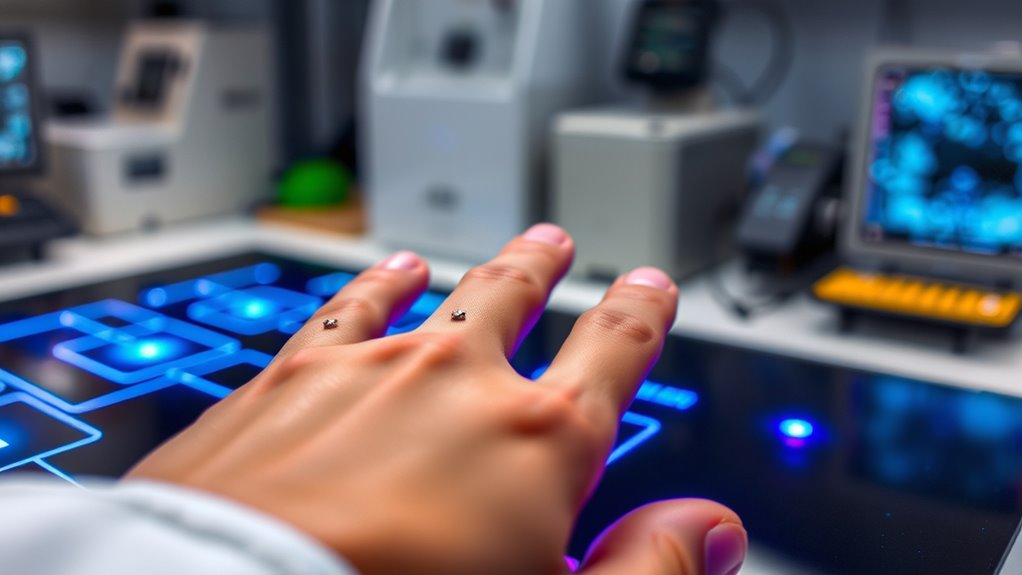
Haptic device technologies enable you to feel virtual objects and textures within augmented environments, creating more immersive interactions. As you incorporate these interfaces, you’ll encounter challenges in seamlessly integrating tactile feedback without disrupting the experience. Addressing these challenges is key to advancing realistic and intuitive touch-based AR applications. Incorporating high refresh rates into haptic systems can improve responsiveness and reduce latency, making tactile feedback feel more natural and synchronized with visual stimuli.
Haptic Device Technologies
Haptic device technologies play a crucial role in bridging the gap between digital and physical experiences within augmented environments. You need durable haptic device components to withstand repeated use and maintain performance over time. Guaranteeing device durability involves selecting robust materials and designing for resilience against wear and tear. Calibration techniques are essential for providing accurate force feedback; regular calibration ensures the device’s responses align with virtual interactions, enhancing realism. Modern calibration methods include automated routines that adapt to device drift or environmental changes. By focusing on durability and precise calibration, you create more reliable and immersive touch experiences. Additionally, understanding Gold IRA Rollovers can inform the development of secure and reliable hardware for financial applications, emphasizing the importance of robust design. These advancements help seamlessly integrate haptic interfaces into augmented environments, making interactions feel natural and convincing.
Immersive User Interactions
Immersive user interactions in augmented environments rely on seamlessly integrating haptic interfaces that respond intuitively to your movements. These systems enhance realism through multisensory integration, combining touch with visual and auditory cues. Haptic feedback can enable sensory substitution, replacing missing sensory input or amplifying sensations for richer experiences. Proper integration ensures the interface feels natural, boosting immersion. Consider the following aspects:
| Aspect | Benefit |
|---|---|
| Multisensory integration | Creates cohesive, immersive interactions |
| Sensory substitution | Compensates for limited sensory input |
| Real-time feedback | Enhances responsiveness and usability |
Additionally, designing these interfaces with a bedroom environment in mind can help create more comfortable and relatable experiences for users.
Challenges in Integration
Integrating haptic interfaces into augmented environments presents several technical and perceptual challenges that can hinder seamless user experiences. One major hurdle is sensor calibration, which guarantees accurate feedback and precise touch interactions. Without proper calibration, users may perceive mismatched sensations, reducing immersion. Additionally, software integration poses significant difficulties, as developers must synchronize haptic feedback with visual and auditory cues in real-time. Compatibility issues between different hardware components can cause latency or inconsistent responses. Achieving smooth communication between sensors and the system requires robust algorithms and adaptable interfaces. Overcoming these challenges is vital for creating natural, intuitive touch experiences within augmented environments. Addressing sensor calibration and streamlining software integration are essential steps toward fully realizing the potential of haptic technology in AR. Moreover, ongoing research into user perception and the refinement of feedback mechanisms will be crucial for advancing the realism and effectiveness of haptic interfaces.
Challenges in Achieving Precise and Realistic Touch Perception
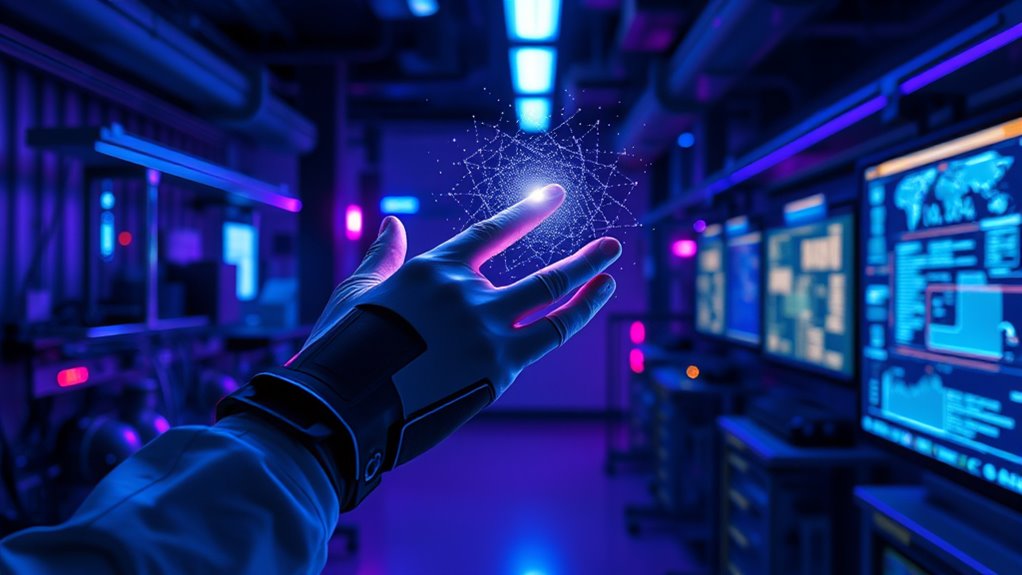
Achieving precise and realistic touch perception in augmented reality systems remains a significant challenge because recreating the nuanced sensations of real-world contact involves complex hardware and software coordination. Sensory augmentation techniques aim to simulate textures, pressures, and vibrations, but maintaining perception fidelity is difficult due to limitations in haptic device resolution and response time. Variability in individual touch sensitivity further complicates consistent experiences. Achieving high fidelity requires integrating multiple sensory inputs seamlessly, which demands sophisticated algorithms and hardware synchronization. Additionally, balancing system responsiveness with comfort and ergonomics is critical. Without overcoming these hurdles, AR touch interfaces risk feeling unnatural or imprecise, undermining user immersion. As a result, researchers continue to explore innovative solutions to enhance the accuracy and realism of tactile feedback in augmented reality environments. High-quality equipment is essential for developing and testing advanced haptic devices capable of delivering more realistic sensations.
User Experience and Ergonomics in Touch-Centric AR Systems

As you interact with touch-centric AR systems, comfort and fatigue become key factors in your experience. Ensuring interfaces are accessible and easy to use helps you stay engaged without frustration. Thoughtful hardware design plays a vital role in making your interactions ergonomic and sustainable over time. Paying attention to user comfort can significantly improve your overall experience with these innovative systems.
Gesture Comfort and Fatigue
While touch-based gestures in augmented reality can enhance interactivity, they also pose challenges related to comfort and fatigue. Repeated or prolonged gestures may cause strain, especially if you rely on wearable gloves that restrict natural movement or increase effort. Sensory adaptation can help by reducing the need for excessive force or continuous motion, making gestures feel more natural over time. However, poorly designed gestures or uncomfortable equipment can lead to fatigue, decreasing your overall user experience. To improve comfort, designers should focus on minimizing effort, supporting ergonomic hand positions, and incorporating adaptive technologies that respond to your movement patterns. Additionally, understanding relationship dynamics can aid in creating more intuitive interactions that resonate emotionally with users, thereby enhancing overall satisfaction. Balancing responsiveness with ergonomic considerations is essential to prevent fatigue and ensure sustainable, comfortable AR interactions.
Interface Accessibility and Ease
Designing touch-centric AR interfaces requires careful attention to accessibility and ease of use to guarantee a seamless experience for all users. You need to consider visual privacy to prevent unintended observations and enhance user comfort. Social acceptance also plays a crucial role; interfaces should avoid drawing unwanted attention or causing discomfort in public settings. Clear visual cues and intuitive controls help users navigate effortlessly, reducing frustration. Here’s a quick overview:
| Feature | Benefit | Consideration |
|---|---|---|
| Privacy Indicators | Protects user privacy | Visible cues prevent accidental sharing |
| Simplified Controls | Ease of use for diverse users | Minimize complexity |
| Social Compatibility | Enhances social acceptance | Discreet design, non-intrusive |
| Accessibility Options | Inclusive for all users | Customizable features |
Ergonomic Hardware Design
Creating an ergonomic hardware design for touch-centric AR systems is essential to guarantee user comfort and prevent fatigue during extended use. Incorporating wearable sensors can enhance the ergonomics by providing real-time feedback on posture and pressure, allowing for adjustments that reduce strain. When designing hardware, focus on lightweight, breathable materials that conform to your body’s natural movements. Ergonomic ergonomics ensure that devices fit comfortably without restricting motion or causing discomfort. Think about the placement of controls and sensors, making sure they’re accessible and don’t require awkward gestures. Properly designed hardware minimizes muscle fatigue and improves overall user experience, encouraging longer and more natural interactions with AR environments. Prioritizing ergonomic principles and wearable sensors leads to more intuitive and comfortable touch-based AR systems. Understanding user needs is crucial for developing hardware that truly complements natural interaction patterns.
Applications of Touch-Enabled AR in Education, Healthcare, and Gaming
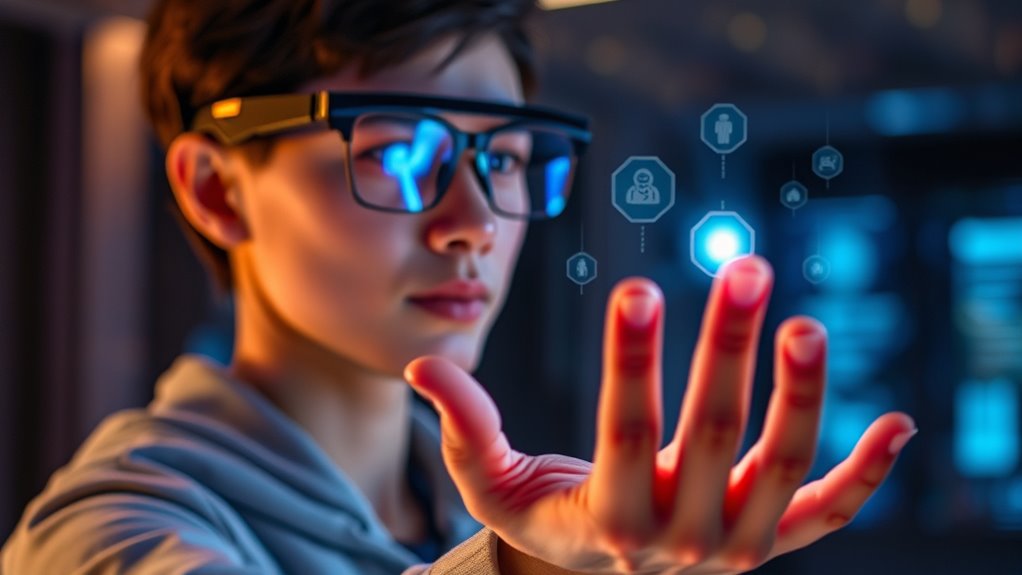
Touch-enabled augmented reality (AR) is transforming how we learn, heal, and play by providing immersive and interactive experiences. In education, AR creates virtual classrooms where students can manipulate 3D models and engage with content through touch, making lessons more engaging. In healthcare, AR enhances medical training by allowing practitioners to practice surgeries or diagnose conditions using realistic, touch-interactive simulations. These applications improve skill retention and confidence without risk to patients. In gaming, touch-enabled AR offers immersive experiences that respond to your gestures, making gameplay more intuitive and engaging. Overall, these applications demonstrate how touch AR bridges the gap between digital and physical worlds, offering practical, hands-on opportunities that improve learning, healthcare outcomes, and entertainment. Recognizing the importance of emotional support can further enhance the integration of touch AR by addressing users’ emotional needs during these immersive experiences.
Future Directions and Emerging Trends in AR for Touch
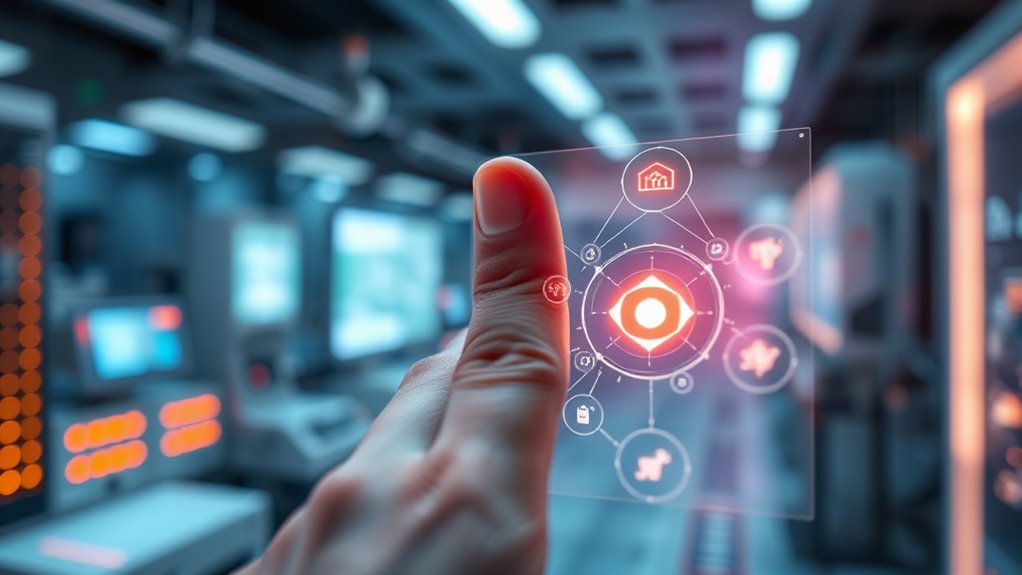
As augmented reality continues to evolve, the integration of advanced touch interfaces promises to open new possibilities for immersive experiences. Future trends focus on sensory augmentation, enhancing how users perceive virtual objects through tactile feedback. This will allow you to feel textures, temperature variations, and shapes more realistically. Environmental mapping will become more sophisticated, enabling AR systems to accurately understand your surroundings and adapt interactions accordingly. These advancements will lead to more seamless and intuitive touch-based AR applications, bridging the gap between digital and physical worlds. Expect innovations like haptic gloves and surface-based touch feedback that respond dynamically to your movements. Together, sensory augmentation and environmental mapping will push AR toward fully immersive, context-aware experiences, transforming how you interact with digital content in everyday settings.
Frequently Asked Questions
How Do Tactile Feedback Systems Impact User Safety in AR Environments?
Tactile feedback systems considerably influence your safety in AR environments. Proper haptic calibration ensures signals are accurate and safe, preventing discomfort or injury. Safety protocols guide the design to avoid overstimulation or unintended touches that could cause harm. When these elements are well-implemented, you can enjoy immersive experiences confidently, knowing that your tactile interactions are calibrated for safety and that protocols are in place to minimize risks during use.
What ARe the Cost Implications of Advanced Touch-Based AR Technologies?
When considering advanced touch-based AR technologies, you’ll find that the cost implications involve a thorough cost analysis and significant infrastructure investment. These systems often require high-end hardware, sensors, and software development, which can be expensive initially. However, investing in these technologies can lead to long-term benefits like improved user engagement and productivity, making the upfront costs worthwhile. Be prepared for ongoing maintenance and upgrades as the technology evolves.
How Do Cultural Differences Influence Tactile AR Interface Design?
When it comes to designing tactile AR interfaces, you’re walking a tightrope, balancing cross-cultural perceptions and tactile variation. Different cultures interpret touch signals uniquely, so what feels intuitive in one place might be confusing elsewhere. You need to adapt tactile feedback to respect these differences, ensuring your design resonates universally. By understanding cultural nuances, you create more inclusive, effective AR experiences that speak directly to diverse users.
Can Touch-Based AR Systems Adapt to Individual User Sensitivities?
You can see that adapting touch-based AR systems to individual sensitivities involves overcoming personalization challenges. These systems require precise sensory calibration to match each user’s tactile preferences and thresholds. By integrating adaptive feedback and user-specific adjustments, you guarantee a more natural and comfortable experience. Although challenging, addressing these calibration issues makes AR touch interactions more accessible, ultimately enhancing user satisfaction and usability across diverse populations.
What ARe the Long-Term Effects of Extended Use of Touch-Centric AR Devices?
You might worry about long-term effects, but research shows that extended use of touch-centric AR devices can lead to haptic adaptation, where your sensory responses become more efficient. However, there’s also a risk of sensory fatigue, which might cause discomfort or reduced sensitivity over time. To prevent this, developers are exploring adaptive feedback systems that balance stimulation, ensuring you enjoy prolonged use without adverse effects.
Conclusion
You see, advancing tactile feedback, refining gesture recognition, and integrating haptic interfaces all aim to enhance your touch experience in AR. Overcoming challenges in realism, precision, and ergonomics is essential to creating seamless, immersive interactions. As you explore education, healthcare, and gaming, remember that the future of AR for touch depends on innovation, collaboration, and dedication. Together, these efforts will shape a world where touch in AR feels natural, intuitive, and truly transformative.

